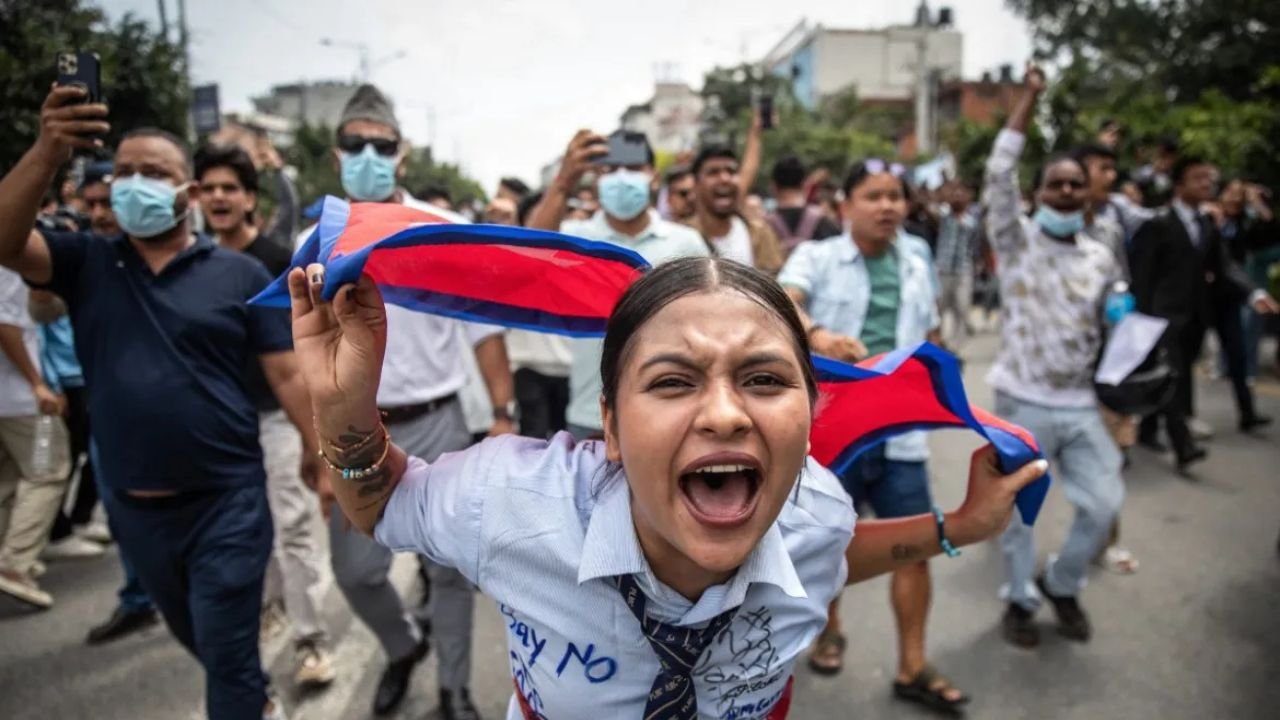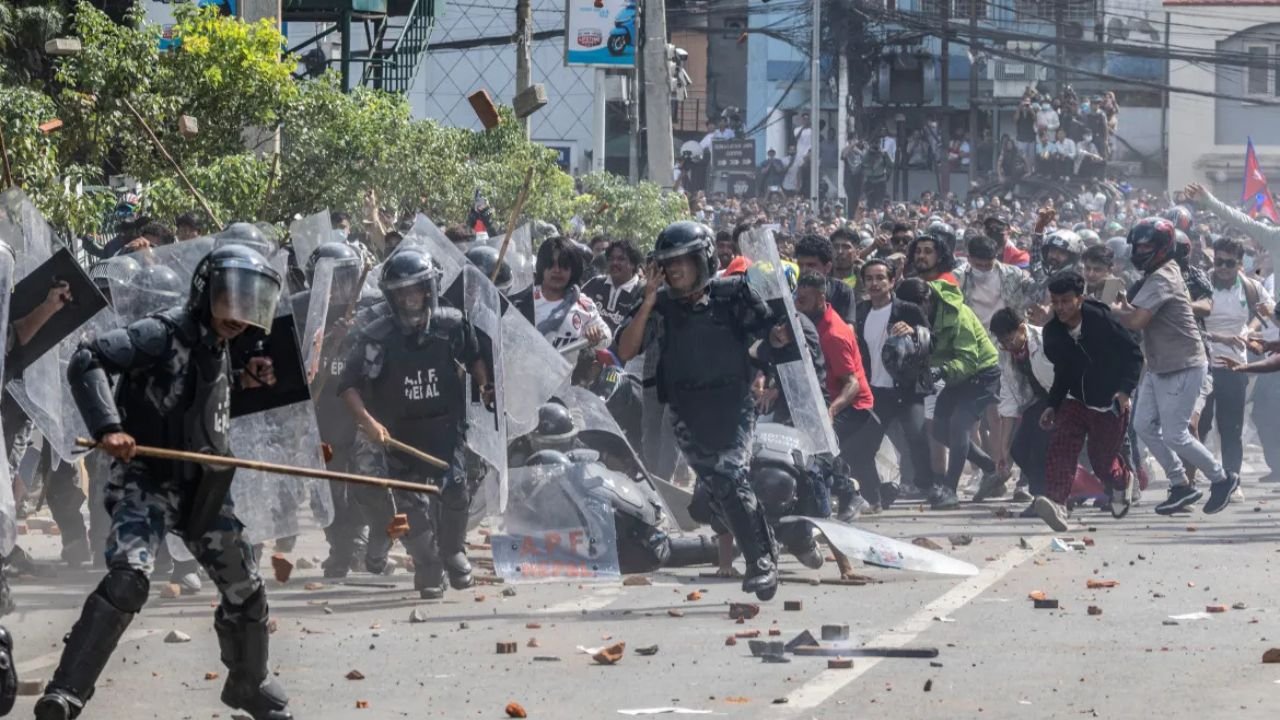Table of Contents
Why Young Nepalis Are Rising Against Corruption and Censorship
Over the past week, Nepal has witnessed some of its most intense and youth driven demonstrations in recent memory. Popularly called the “Gen Z protests in Nepal,” these rallies began as a reaction to a controversial social media ban but quickly grew into a nationwide movement against corruption, censorship, and political instability.
What makes these protests significant is not just their scale, but also the demographic leading them. Thousands of young Nepalis mostly students and first time voters have taken to the streets, showing frustration with leaders they see as corrupt, disconnected, and unwilling to reform.
What Triggered the Nepal Protests?
The spark came when the Nepali government banned 26 social media platforms, including Facebook, X (formerly Twitter), YouTube, Instagram, and WhatsApp. Officials defended the move by claiming that these companies had failed to register with Nepal’s Ministry of Communications and Information Technology.
The government argued the restrictions were necessary to curb hate speech, fake news, and online scams. But for most Nepalis, especially the youth, the ban was seen as a direct attack on freedom of expression.
To many, this was more than just about apps it was about their voices being silenced. In a country where young people rely on social media not only for entertainment but also for education, networking, activism, and job opportunities, the move felt like an authoritarian attempt to control dissent.
Deeper Issues: Why Young Nepalis Are Angry
While the social media ban in Nepal lit the fire, the anger behind the protests runs much deeper. Years of frustration with corruption, nepotism, and political instability had already created a powder keg.
Here are the key grievances fueling the demonstrations:
- Corruption everywhere: Many Nepalis believe that corruption runs deep in government institutions. Bribes, favoritism, and misuse of funds have become part of daily governance.
- Nepotism and privilege: Young people accuse political elites of protecting their families and friends, giving them special access to jobs and resources while the rest struggle with unemployment and poverty.
- Political instability: Nepal has seen frequent leadership changes, coalition collapses, and weak governance. This constant instability has eroded public trust in politicians.
- Lack of opportunities: Despite being highly educated, many young Nepalis feel they have no clear future at home and are forced to look abroad for work.
Gen Z protests in Nepal, the protests are not just about social media they are about demanding a fairer system that works for ordinary citizens, not just for the powerful few.

How the Gen Z Protests Spread Across Nepal
At first, students and youth groups began small rallies in Kathmandu, but soon the protests exploded nationwide. Demonstrators gathered in large numbers outside government offices, universities, and even Parliament.
Protesters tried to storm key government buildings, breaking through barricades in some places. Security forces responded with tear gas, water cannons, rubber bullets, and in some cases, live ammunition.
Unfortunately, the situation turned deadly. In the early stages, at least 19 protesters were killed, and the number later rose to over 50 deaths, with hundreds injured.
The protests escalated further:
- Government buildings and offices were set on fire.
- Protesters targeted the homes of politicians.
- Curfews were declared in several districts.
- The army was deployed to control crowds.
- Over 12,000 prisoners escaped during the chaos, creating additional security challenges.
These dramatic events showed just how powerful and uncontrollable the movement had become.
Government Response: From Crackdown to Resignation
At first, the government stood firm, defending the social media ban and cracking down on demonstrators. But as protests grew and international criticism mounted, the pressure became too much to handle.
- The social media ban was lifted after a week of chaos.
- Prime Minister KP Sharma Oli resigned, along with several ministers.
- Nepal appointed its first female Prime Minister, a historic shift in leadership.
Still, the damage had already been done. Public trust was at an all-time low, and questions about government accountability remained.
Why These Protests Matter
Gen Z protests in Nepal are not just another political demonstration they represent a turning point in the country’s future. Here’s why:
- Generational awakening: A new generation of Nepalis, connected, educated, and digitally active, is demanding change. They no longer accept corruption and nepotism as normal.
- Digital activism as power: Social media, ironically the very thing banned, became the symbol of protest. Young people found ways to organize, spread information, and share videos of police crackdowns despite restrictions.
- Challenge to legitimacy: By resigning, Nepal’s leaders admitted they had lost the people’s trust. This is a wake up call that citizens, especially the youth, will no longer stay silent.
- Uncertain future: The Gen Z protests in Nepal brought hope for reform, but also fears of further instability. If reforms are not delivered, frustration could boil over again.
Challenges Ahead
The protests may have achieved short term wins lifting the ban and forcing resignations but the real test lies in what comes next.
- Accountability: There must be transparent investigations into the deaths and police violence. Without justice, anger will fester.
- Political reform: Young people want an end to corruption and nepotism. Without structural change, Nepal risks repeating the same cycle of instability.
- Balancing freedom and security: The government faces pressure to maintain law and order, but crackdowns on free speech will only fuel more unrest.
- Restoring trust: Leaders must actively listen to Gen Z and include them in the decision-making process. Ignoring their voices is no longer an option.
Conclusion: A Turning Point Gen Z protests in Nepal
The Gen Z protests in Nepal started with a ban on social media, but they quickly transformed into something much bigger a national cry for accountability, freedom, and fairness.
For the young protesters, this is not just about apps or censorship; it’s about building a future where their voices matter. For the government, it is a wake up call: either embrace reform and transparency or risk losing legitimacy altogether.
Nepal now stands at a crossroads. The outcome of these protests will decide whether the country moves toward a more open and democratic system or slips deeper into instability.
One thing is certain: the youth of Nepal have spoken, and they are not going back to silence.
